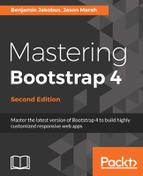Chapter 1, Revving Up Bootstrap, places the Bootstrap framework into context by highlighting the relevant features that come bundled with it. It briefly deals with various ways to include the framework and concludes by setting up the required files for the book’s demo project.
Chapter 2, Making a Style Statement, introduces the Bootstrap markup and style rules for the mobile-first grid system and HTML image elements. It also goes into the handy helper classes and responsive utilities that Bootstrap makes available to boost development speed.
Chapter 3, Building the Layout, focuses on starting to flesh out the demo project set up in Chapter 1, Revving Up Bootstrap, by adding a style guide for commonly used HTML elements and structuring the page layout.
Chapter 4, On Navigation, Footers, Alerts, and Content, shows you how to take advantage of Bootstrap to build footers and alerts, and how you can add and style various types of content using Bootstrap’s built-in classes.
Chapter 5, Speeding Up Development Using Third-Party Plugins, demonstrates how to use the handy third-party jQuery plugins to add interactivity and fun to a web page.
Chapter 6, Customizing Your Plugins, delves into the Bootstrap jQuery plugins’ code and customizes it to jazz up this book’s demo page. Plugins will be examined and extended throughout this chapter in an effort to not only make our page better, but to also improve our knowledge of how jQuery plugins are built and how they behave within Bootstrap’s ecosystem.
Chapter 7, Advanced Third-Party Plugins, identifies new features or improvements that we want to make to our demo website. Consequently, the chapter will introduce libraries to help us achieve those goals and figure out how these can be gracefully integrated with our existing architecture.
Chapter 8, Utilities, aims to close any knowledge gaps that we may have of Bootstrap 4 by taking a look at Bootstrap's various utility classes and teaching you how you can use them effectively to speed up website development.
Chapter 9, List Groups and Accordions, shows how your website can be optimized for maximum performance and fast loading time on any device.
Chapter 10, Optimizing Your Website, covers how your website can be optimized for maximum performance and fast loading time on any device.
Chapter 11, Integrating with AngularJS and React, teaches the essentials of using Bootstrap within AngularJS and React. AngularJS is a Model-View-* JavaScript framework, while React is a JavaScript library that concentrates solely on the View part of the Model-View-Controller type stack. A vast amount of web pages are built with the frameworks or libraries, such as AngularJS and React, as they provide very useful abstractions on top of JavaScript and the DOM.
